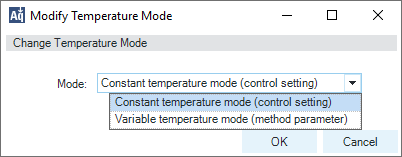Temperature Mode
Selecting Modify > Temperature Mode in the Control Interface will prompt a dialog box, where the temperature control mode can be switched between being a method parameter or a system (control) setting:
Constant Temperature Mode: The temperature control mode is defined as a system (control) setting, meaning that the temperature setting is independent of the method parameters. The temperature stays constant for all methods within a given sequence. This control mode is the default option and recommended for most applications.
Variable Temperature Mode: The temperature control mode is defined as a method parameter, meaning that the temperature setting is part of the method parameters. The temperature can change from method to method within a given sequence. This control mode is not recommended for most analytical workflows but might be used for some special applications, such as degradation studies.
NOTE
For modifying the temperature mode, LC & CE drivers A.02.12 or higher are required. If the system is run on an earlier driver version, the temperature mode is defined as a system setting.

Before using the Variable Temperature Mode setting, here are some hints and tips to consider:
Changing the temperature setting from one method to another will affect all samples inside the sampler.
Depending on the extent of the temperature change, it could take up to a couple of hours until the sample temperature stabilizes at the new setpoint (for example, from 4 to 40 °C or vice versa).
It might be beneficial to use the Temperature within +/- 2 °C function; otherwise, the next run will start without waiting for the new setpoint being reached.
base-id: 3714810123
id: 18014402224292107